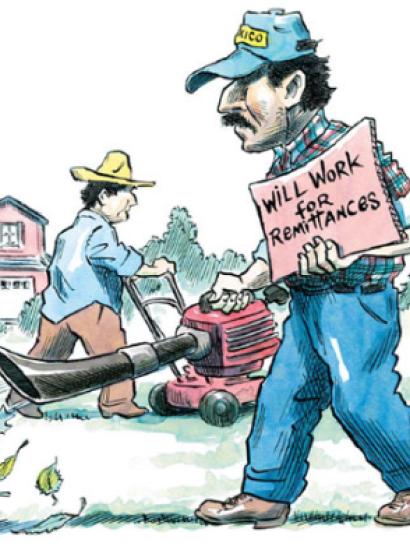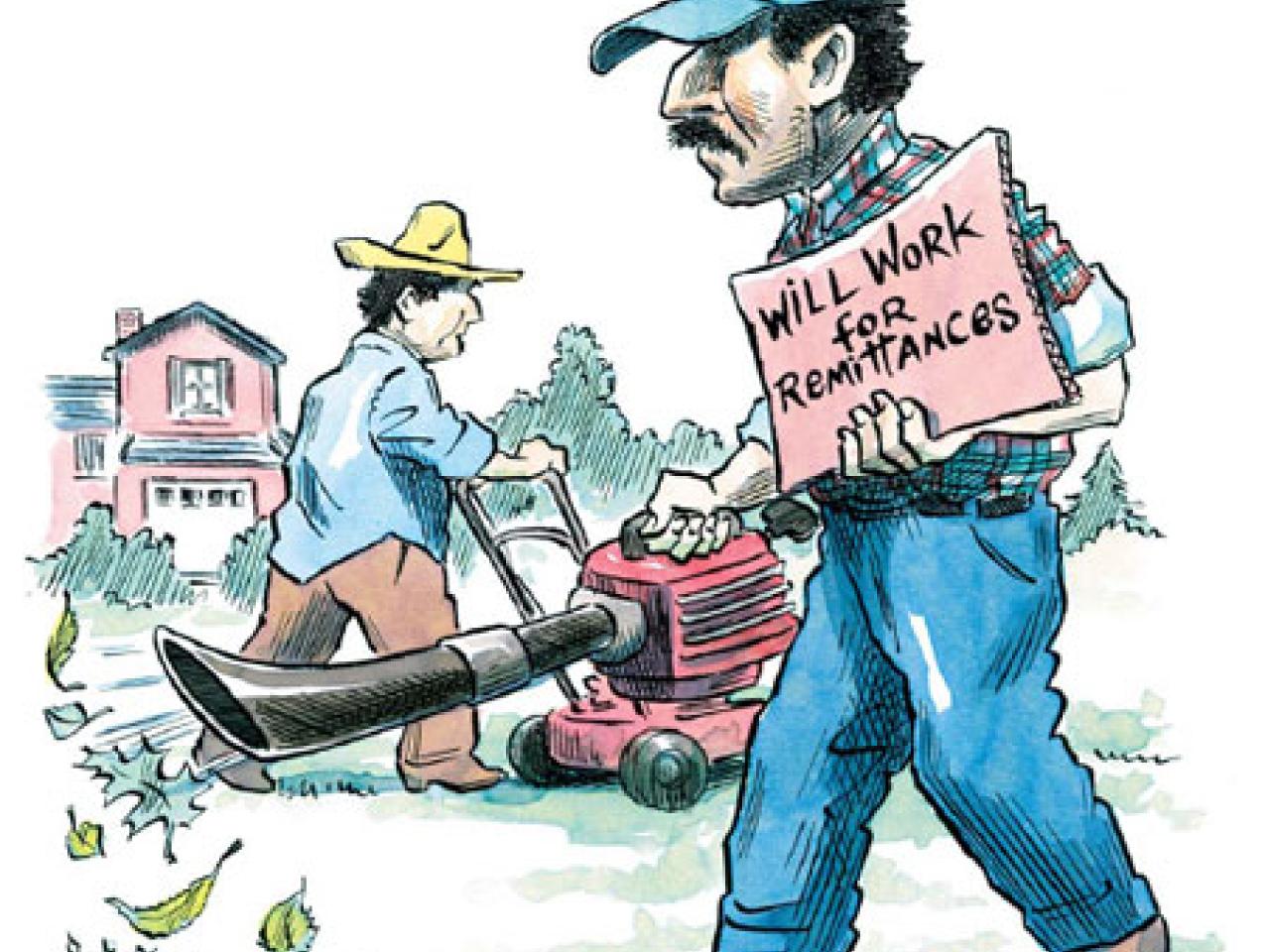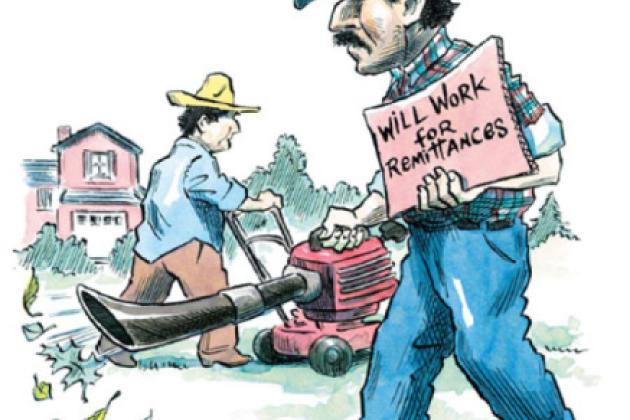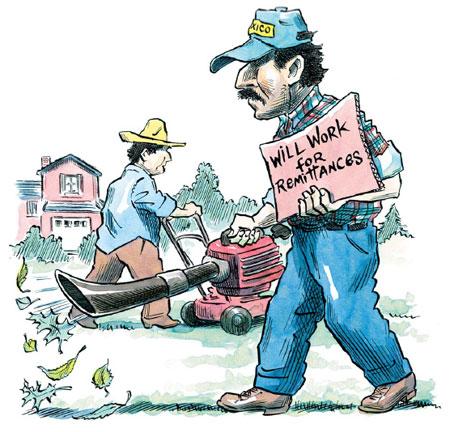- US Labor Market
- International Affairs
- US Foreign Policy
- Immigration
- Economics
- Law & Policy
The United States is not the only nation struggling with illegal immigration. The problem is worldwide. Costa Rica is flooded with Nicaraguans, France with North Africans, Argentina with Paraguayans, Russia with Georgians, China with North Koreans. Illegal residents are a bane or a blessing throughout the world, depending on who benefits from their presence—or absence. In this country, responding to increasingly vocal demands from all sides of the political spectrum, lawmakers are pushing for more border fencing, more Border Patrol agents, and harsher punishment of illegal migrants and those who smuggle them in. President Bush, meanwhile, calls for a new “guest worker” program.
If immigration matters are not handled carefully, U.S. policymakers risk making matters worse for everyone: giving 10 million to 12 million illegal immigrants in the United States a path to citizenship, for example, will encourage those already here to stay and will invite more to come here illegally. And it will undermine the best hope for prosperity and development of the countries they come from: remittances, the money those migrants send home.
We know that poverty generates instability and violence and is bad for peace and commerce. And poverty in Latin America drives illegal immigration to the United States. For more than a half-century the rich world’s response to Third World poverty has been to send poor nations foreign aid, believing that given enough money and advice, they will develop themselves. Americans have poured hundreds of billions of dollars into this effort, and virtually all of it has been wasted. Third World elites have grown fat, but their poor have remained poor. And it is their poor who are flooding into developed countries.
Once I asked the director of the U.S. Agency for International Development (AID) mission in Paraguay for a list of countries that had been developed thanks to foreign aid, and he handed me a blank piece of paper. When I looked shocked, he said: “You don’t understand. We don’t develop countries. We just run projects.” In private conversations, AID professionals call foreign aid “the process of taking money from the poor people in rich countries and giving it to the rich people in poor countries.”
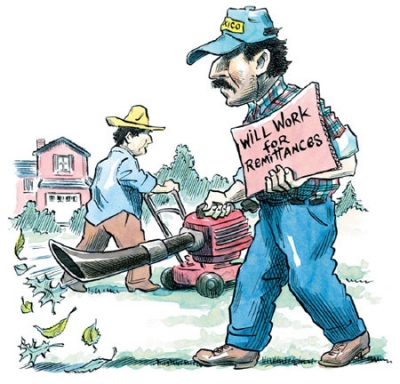
But what governments and international civil servants have failed to accomplish with their top-down approaches, individuals in pursuit of their own self-interest have been doing well, financing the development of their countries of origin from the bottom up. Remittances are the key to their success. According to the World Bank, official development assistance around the world in 2006 was $60 billion, $20 billion from the United States. That same year, money sent home by foreign-born workers reached almost $300 billion, five times as much. Not only that, but most of the official assistance went to cover the inflated overhead costs of the foreign and local bureaucracies that administer it. By contrast, remittances go directly from poor foreign workers to their even poorer families. Those families spend the money to educate their children, get better health care, and improve their homes; with what’s left, a growing number of them start small businesses.
We in the United States have been so busy corralling individuals one by one, plugging holes in border fences, and competing against one another for political advantage that we’ve lost sight of the origins of the problem, the standard-of-living gap between rich and poor countries. Even worse, we’ve been pretending that illegal immigration is a supply-only problem when, just like any commercial activity, it’s the product of both supply and demand. The supply side has its origins in the workers’ home countries. Those who stay home can expect only very low-paying jobs and a future of poverty for themselves and their families. If they come to the United States, they can find jobs that pay enough for them to support themselves, send money home to their families, and often build a financial nest egg. As for the demand side, if there were no U.S. employers offering them jobs, there would be little if any illegal immigration.
We need a holistic approach that looks at illegal immigration not as a political problem but as a business opportunity. By transforming illegal immigration from a large-scale, off-the-books black-market operation into a revenue-producing program that manages the movement of workers in and out of the U.S. economy, we could maximize its benefits to all four major stakeholders—the workers, their employers, the countries the workers come from, and the American taxpayers. In particular, by ensuring that remittances sent home by foreign workers reach their intended recipients as cheaply and efficiently as possible, we could maximize the financial flows reaching the poor in developing countries. This would help those countries prosper, which is the key to eliminating the source of illegal immigration. Such a structure would also assure employers of a stable source of qualified workers. And new fees would pay for overseas development, the operation of diplomatic missions, and other initiatives abroad.
Impossible? Not at all. Here’s how to do it.
Start by recognizing illegal immigration for what it is: nothing more than an immense and highly profitable black market in which millions of willing suppliers sell their services to willing buyers.
By my conservative estimate, last year alone U.S. employers paid illegal workers between $350 billion and $400 billion. These workers then sent billions home to their families as remittances. In a recent study, the Multilateral Investment Fund of the Inter-American Development Bank (IDB) estimated that $63 billion in remittances was sent by foreign workers from the United States to 24 Latin American countries in 2006—including about $24 billion to Mexico, $14 billion to Central America, and most of the remainder to South America or the Caribbean.
Our first step should be to bring both sides of this market under control. On the supply side, the most efficient way to do this would be to add a program for lower-skilled temporary workers to our existing process for bringing in higher-skilled temporary foreign workers. The key to persuading illegal workers who are already here to join the new program would lie in forgiveness, not punishment, in return for future compliance. During a six-month grace period, those already here and employed, and the businesses that employ them, could obtain two-year permits without being penalized for what they have done in the past. Family members already here would be grandfathered into the process once the worker voluntarily signs up, and would be allowed to stay for the two years. Workers could keep their jobs and earn higher incomes, get better benefits and a few other perks such as temporary driver’s licenses, and stop living in fear and uncertainty. Employers could keep their workers.
Once this six-month grace period expired, neither the workers nor their family members would be allowed to stay legally. From then on, two-year temporary work permits could be obtained only at a U.S. consulate in the country of origin, with a one-month minimum wait before they could be renewed—compelling the workers to renew ties to their homelands. If they returned to the United States under a renewed visa, they would not be able to bring any family members with them.
Angered by the breaking of our laws by illegal immigrants, many in the United States want any program that lets them stay to include penalties. But arresting and deporting millions of people will never happen. Even if illegal entrants were deported en masse, the damage would almost certainly exceed any benefits. Families would be torn apart, and the sudden arrival of millions in their countries of origin could cause political and economic upheavals and destabilize the region, beginning with Mexico. In the United States, the sudden loss of millions of workers and consumers would also have a severe impact, especially because we lack legal workers ready to take their places. And overzealous border enforcement could sharply cut the 200 million legal entries from Mexico every year—most of them shopping trips in which Mexicans spend more than $40 billion at U.S. businesses that employ more than a million workers.
A once-only, nonpunitive approach to regularizing the situations of the millions of illegal workers already here and those who employ them would offer a powerful reason for them to participate in the new system and be far more effective and far less costly. And there should be no concern that we are rewarding illegal immigration, because those temporary workers would not be permanent residents or on a track to citizenship, so no “amnesty” is involved.
As for enforcement, creating blacklists of illegal workers and employers who did not regularize their status during the grace period, and then excluding them from the process in the future, would give them yet another powerful incentive to participate. Because a blacklisted employer would not be able to continue employing those who did obtain legal temporary work permits, the workers themselves would have a major stake in ensuring that their employers toed the line. And as illegal residents became scarcer, they would stand out more—making it easier for law enforcement to identify and detain them.
The new program should offer monetary incentives for temporary workers to remain just that—temporary—and then go home when their permits expire, either to stay or to obtain new ones. Temporary workers would be required to deposit 10 percent of their earnings in U.S.-controlled individual escrow accounts in their country of origin as a surety for not violating the terms of their visas. This money would be returned to them with interest, but only after they end their participation in the program and go home.
To improve the incentives to participate, policymakers might even include a way for temporary workers to earn eligibility for immigrant visas after a certain number of years as temporary workers, perhaps by using a point system. Why not? After all, once they have worked hard, paid taxes, and been law-abiding for 15 or 20 years, the workers should be at least as welcome as the sister or brother of someone already here legally. To offer this incentive would require only the creation of an immigrant visa category just for them.
In addition to forgiving employers who have employed illegal labor, the program would require them to register as employers of temporary workers, obtain permits to do so, pay a fee to participate and for each employee, and comply with all laws. To keep and renew their permits, employers would be required to treat their foreign workers the same as all their other workers, including paying minimum or higher wages and withholding money for their taxes, Social Security, and Medicare. They would also withhold other deductions required by the new process. Keeping the financial flows under U.S. government control from beginning to end would make it possible to avoid the abuses of the system that finally sank the 1942–64 bracero program that once brought millions of Mexican temporary workers to the United States.
To make the system work, we would then need to vigorously enforce our immigration laws and retake control of our borders. Congress has already approved and funded some fence building and additional Border Patrol agents, and the president has stationed some National Guard personnel along the southern border. But additional enforcement measures should be taken. Local law enforcement is a greatly underused tool. Police often complain that they are not paid to enforce immigration laws, but there is no reason they couldn’t be given grants to do so—money drawn from the revenue generated by the new visa process. And immigrants who are now afraid to report crimes or otherwise cooperate with police would become an asset to public safety once freed from their fear of deportation.
But although important, domestic enforcement alone would not be enough. Parts of the problem lie beyond our borders
We should also give the countries sending workers powerful incentives to help make the new program work, and money is the best incentive. U.S. authorities should use the financial flows generated by this new system to reward countries that cooperate, a tactic that could include depositing money in foreign private banks. The 10 percent of wages set aside for the workers’ return would be especially appropriate for this approach, as the long-term, stable sources of capital would allow the participating banks to make more loans and higher profits. For Mexican banks alone, this could mean $20 billion a year in new seed capital, and profitable banks make powerful allies.
U.S. authorities should also deposit the workers’ withheld Social Security and Medicare taxes in long-term, U.S.-controlled accounts, to be paid out only when a temporary worker retires in his or her country of origin. This would put yet more billions into a country’s hard-currency reserves and also provide future retirement and medical benefits for millions of its returning citizens.
Most people don’t realize that more than 3 million Americans live abroad and that hundreds of thousands of them receive Social Security and other pensions. During my consular years, we routinely mailed or delivered thousands of checks to retirees in our district. We also regularly investigated their recipients to make sure U.S. laws and regulations were being followed. The Social Security Administration already has offices in some embassies to administer its programs, so extending this service to returning temporary workers could be done simply by strengthening this existing system.
Extending Medicare this way may seem like a nonstarter because, in most cases, the program does not now cover medical expenses abroad. But consider the advantages. Medical expenses in the United States—the highest in the world—are causing huge increases in Medicare spending. Shifting several million Medicare accounts to pay overseas doctors and hospitals who charge less for the same services would save Medicare a great deal of money.
And now the best part: saving the taxpayer money. Charging each temporary worker $500 to obtain a work permit and $50 a month to keep it would gross $8 billion to $10 billion a year, equal to the State Department’s entire international operations budget. Channeling these funds into the State Department would pay for the new consulates, cultural centers, virtual libraries, and consular agencies necessary to make this program work, with money left over for the rest of the budget. New fees paid by employers could pay most, if not all, of the costs of domestic enforcement efforts. Enhancing the financial impact of remittances would let the United States cut back on the $20 billion it spends every year on ineffective foreign aid. And sharply reducing the number of illegal residents would also reduce the costs of offering them health care, education, and other services—and, as a bonus, make it easier to catch drug traffickers, terrorists, and other criminals because they would no longer be able to hide in the shadows of the vast underground economy.
A sovereign nation has both the right and the duty to control its borders and immigration. But the work performed by foreign workers has to be done, and Americans need peaceful borders, prosperous neighbors, and good relations with the countries the foreign workers come from. And we can do all this—legalize and control immigration, lower government costs, help foreign nations, have safer neighborhoods, even turn a profit—just by acting like capitalists.









